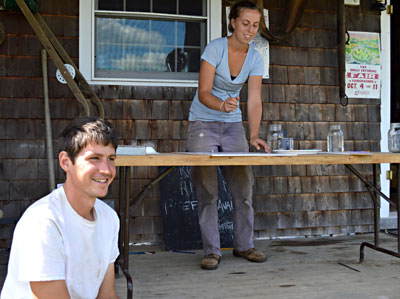 |
| Pheonix Obrien and Megan Gardner are the current farmers-in-residence at MOFGA’s Common Ground Education Center in Unity. This photo shows them preparing for MOFGA’s Common Ground Country Fair, which takes place right outside the farmhouse where they live during their residency. English photo |
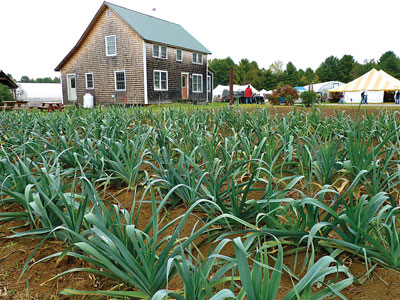 |
| Farmers-in-residence grow crops on MOFGA’s grounds, enabling them to begin a farming business without the immediate overhead of paying for land and housing. Tents for the Common Ground Country Fair are in the background in this photo. English photo |
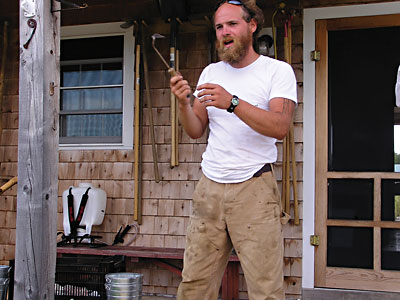 |
| Chris Cavendish of Fishbowl Farm (now in Bowdoinham) brought commercial-scale production to the farmer-in-residence position. All FIRs also do workshops during the Fair and at other MOFGA events. English photo |
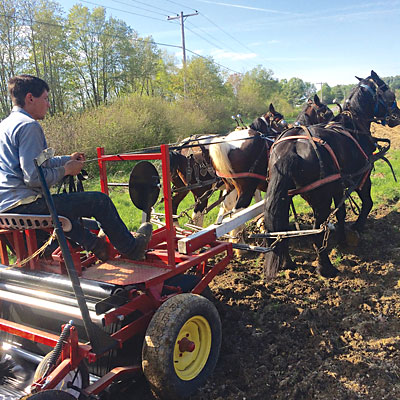 |
| Sandy Meadow Farm produces 6 to 7 acres of MOFGA-certified organic storage crops and grains using horse power, including a pair of Spotted Draft geldings and a Percheron mare. Megan Gardner photo |
By Holli Cederholm
The 250-plus acres of land in Unity, Maine, on which MOFGA operates its educational programs and organic certification services, is perhaps best known as the “fairgrounds.” Tens of thousands of attendees annually flock there to attend MOFGA’s Common Ground Country Fair for a long September weekend, the third weekend after Labor Day. Hayfields rimming the property become parking lots to fairgoers from around the state and across the country. Tents crop up between the demonstration gardens and orchards to host an exhaustive exhibition of organic agriculture and sustainable living.
Inside this web of activity is a working farm − albeit in a nontraditional sense.
Every two years, MOFGA invites new stewards to live and farm organically on site in an incubator farm called the Farmer-in-Residence (FIR) Program. This initiative falls under the umbrella of MOFGA’s Journeyperson (JP) Program, which is designed to bridge the education gap between farm apprenticeship and independent farmer. The JP Program, started in 1999, now provides hands-on support and mentorship to some 50 beginning farmers each year − with MOFGA’s on-site farmers accounting for one or two of them.
The FIR Program “is a way to get new farmers started on their own, with a safety net,” says MOFGA Educational Programs Director Daniel MacPhee, who joined the staff in 2015. He explains that it provides an important opportunity for new farmers who lack land access but are otherwise ready to take the next step to independent farm management. “It’s a place where MOFGA can provide the land base that they need, so that they can get their farm business started and then take that business to their forever farm, hopefully.”
MOFGA’s Farmstead
Since its inception in 2001, the FIR Program has invited eight cycles of farmers to live in an ecologically designed farmhouse on site and to cultivate the surrounding envelope of land for durations varying from one to three years.
With each farmer, the landscape and infrastructure has shifted according to the needs of the farmers’ own budding businesses. MOFGA’s first educational programs director, Andrew Marshall, who held the position from 2003 until 2014, recalls that the first few residents were largely homesteading on the property.
He credits Chris Cavendish, owner of Fishbowl Farm (now in Bowdoinham, Maine), with raising the bar of using this time and space to grow and export a working farm business. “He was really the one who kind of started the trend of commercial production,” says Marshall.
Cavendish broke up additional ground adjacent to the alley crop gardens in the south orchard, expanding the land in rotation to 2 acres. He also helped construct a 2,150-square-foot unheated moveable greenhouse, which was donated to MOFGA and suffered wind damage beyond repair a few years ago.
The FIR Program is tailored to the individual farmer on the grounds, and the farmstead reflects that. “From one to the next, the farm that is incubated could be totally different,” says MacPhee.
The small farm infrastructure on site has been added bit by bit, driven by the farmers at the time. Many of the projects are spearheaded by the farmers themselves, with each FIR cycle contributing an infrastructure project. Past examples include a wood-fired earth oven, a stand-alone walk-in cooler, a moveable barn for pastured goats and an on-farm poultry processing facility.
“A lot of what’s been happening is trying to build up infrastructure on the fly,” says MacPhee. Most of that has been geared toward producing fresh vegetables for farmers’ markets, Community Supported Agriculture (CSA) shares, restaurants or some retail-wholesale combination. “It had been vegetables, vegetables, vegetables, vegetables over the years.”
MacPhee says the current FIRs’ diversified livestock operation is driving conversation around more permanent projects for the site. He lists perimeter fencing, space for hay storage and winter housing for animals as top priorities for MOFGA. “A lot of the things that are lacking are not things that the farmers-in-residence are going to be able to take away with them when they move their operation.”
Sandy Meadow Farm
The present FIRs, Pheonix Obrien and Megan Gardner, agree that livestock housing is a challenge, but that hasn’t slowed the trajectory of their diversified livestock and crop operation.
They enrolled in the FIR Program in 2014, after working together for a season at Freedom Farm in Freedom, Maine. In accordance with JP Program requirements, each had worked a minimum of two seasons on other farms.
Obrien began as an apprentice at Freedom Farm and then spent four years as a farm manager: first at horse-powered Mandala Farm in Gouldsboro, Maine, and then back at Freedom.
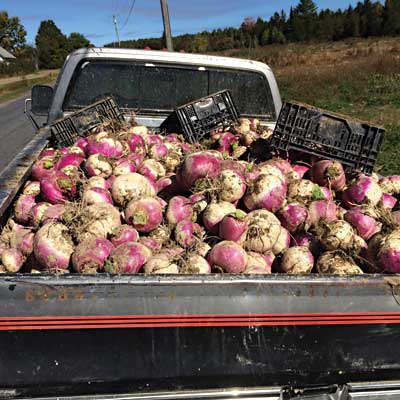 |
| Sandy Meadow Farm specializes in storage crops, including these Purple Top White Globe turnips, for wholesale markets. Megan Gardner photo |
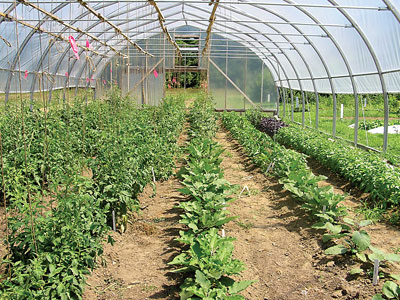 |
| The infrastructure and landscape of MOFGA’s working farm is shaped by the business plans of each FIR. Previously, direct market vegetable growers often alternated planting a 2,150-square-foot moveable greenhouse in tomatoes and cold-hardy greens. English photo |
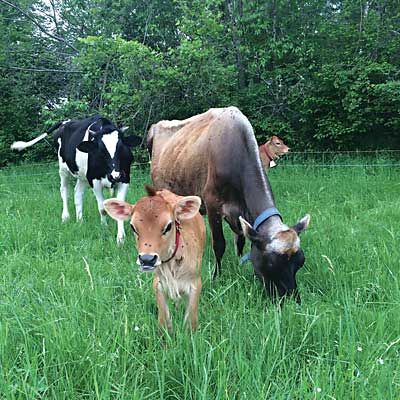 |
| Obrien and Gardner are excited about establishing a grass-based commercial dairy to direct market raw milk. They started with one Jersey and one Guernsey-Jersey cross, both bred to a Jersey bull and freshened last spring. Megan Gardner photo |
After his seventh season and Gardner’s second, they were ready to farm on their own. Obrien was already working toward this goal. In 2009 he started purchasing equipment, and in 2012 he acquired his first team of draft horses − a pair of Spotted Draft geldings named Bill and Bob.
Like many beginning farmers he lacked the capital to invest in a new business from the ground up. “It was the only way he could have started farming independently,” says Gardner. “The alternative would have been living somewhere and working for somebody and saving money with the intention of starting our own farm.”
They came to the FIR Program, as all applicants do, with a loose business plan in place. “The original plan, Pheonix’s plan, was to grow storage crops and sell them wholesale, and that is pretty much exactly what we have done,” says Gardner.
The farmers produce the full spectrum of root vegetables, including beets, carrots, parsnips and storage brassicas, such as rutabagas, turnips and winter radishes, in a row crop system using horses − Bill and Bob and a Percheron mare named Heaven.
By opening an additional 5-acre parcel on the north end of MOFGA’s property, Gardner and Obrien now produce 6 to 7 acres of crops overall, including other storage staples − potatoes, garlic, winter squash and cabbage – rotated with large grains, such as corn and dry beans.
“We’ve tried to focus on selling to midsized distributors,” says Gardner. They have largely targeted the health food store market in Portland, with over 75 percent of their vegetables going to just three accounts: Rosemont Produce Company, Native Maine and Whole Foods Market.
Upon closing out their 2016 growing season, Obrien and Gardner hope to buy their own farm in Maine – preferably in central Maine and ideally in Waldo County. A barn, housing for their animals, and 30 to 40 open acres are key considerations in their search.
“We make our own feed and want to have the ability to continue to do that,” says Gardner. This requires hayfields and enough tillable land to include grains, used in part for animal feed, in their annual vegetable crop rotation.
Gardner says, “The biggest challenge about living here is that we can’t make feed for our animals here.”
MacPhee attributes this to the competing needs of the Fair on MOFGA’s landscape. Although only three days a year, the impact of the Fair on the site is clearly visible for the rest of the year. For instance, most available pasture areas and hayfields double as parking lots for the Fair. “The space doesn’t have full use as a normal farm would, and so they need to, with us, figure out how to accommodate that,” says MacPhee.
And they do. The pair graze their three horses and four dairy cows on MOFGA pasture until late September and then switch to feeding hay harvested with horses on leased land. “We need about 180 bales per mature animal and about half of that for immature,” says Gardner. “So the two heifers would each need 90 … That’s a 40- or 50-pound proper square bale.”
After managing their Sandy Meadow Farm at MOFGA for three years, they feel qualified to make the leap to farm owners. After filing a Schedule F to the IRS for three years, they will meet the qualifications for a Farm Ownership loan through the USDA Farm Service Agency (FSA). “We’ve already talked to the FSA and feel pretty confident about that,” says Gardner.
Both agree that a lot of the FIR experience involves gaining confidence as business owners, but also as farmers.
“With the vegetables … we’ve made mistakes. More mistakes than we thought we would,” says Gardner. They plant, observe and adapt, taking stock of what they’re going to do differently − next month, next year, next farm.
One of the biggest advantages of the program, says Gardner, is that it has allowed them to experiment with different enterprises, such as their starter herd of Jersey cows. “It might have been cheaper to just buy four mature animals when we were ready to just run a dairy that we could sell milk out of, but we’ve learned so much from having them and having managed them before we have to make them a profitable enterprise.”
Obrien adds, “Being able to get a handle on our cost of production has been huge.”
“We made money last year and we made money this year. We’ve been technically running a profitable business,” says Gardner. She speculates that this profit margin is largely due to reduced overhead. While they own the bulk of their equipment, they occasionally use the tractors and implements available through MOFGA. Unlike most new farmers, they are not paying a mortgage. The position comes rent-free and provides a $3,000 annual stipend.
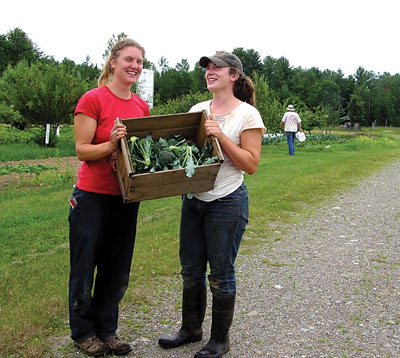 |
| Molly Crouse (left) and Christa Bahner, former FIRs, now operate their own Maine farms with their husbands. English photo |
Growing Maine Farmers
Former FIR Christa Bahner credits her success as a farmer directly to the program. She calls it a way for beginning farmers to trial running their own farm business with minimal risk and little financial outlay.
“Actually it seemed like a lot at the time, but it was just like seeds and some amendments, and we were ready to go because everything else was already there … We were able to run a business for two years without 90 percent of the risk.”
After starting Double Bit Farm with Molly Crouse through the FIR Program, both Bahner and Crouse secured their own land through the FSA Farm Ownership loan. Now both manage, along with their husbands, their own MOFGA-certified organic direct-market produce farms: Bahner Farm, in Belmont, Maine, and Nettie Fox Farm in Newburgh, Maine, are both entering their seventh season in operation.
“The average success rate for farms, in their first five years, is less than 50 percent,” says MacPhee, who proudly points out that 92 percent of JP alumni all the way back to 1999 are still running successful farm businesses today.
A hearty 87 percent of those businesses are in Maine. “Maine is one of the few states where the average age of farmers is going down, and we’re actually significantly increasing the number of organic farms and organic farmers, and also land in organic production.” The number of farmers supported by MOFGA’s JP Program has contributed a significant percentage of that number, says MacPhee.
He adds, “MOFGA has a really unique model. We have a lot of people come to us to ask for advice and to emulate the program, and wonder as far as the amount of resources that we’re putting into these people, what are we getting out. It seems like the return is incredible.”
The investment is significantly higher for resident farmers than for JPs. Marshall, now the education and field director at Land for Good, says, “I like the incubator model … It’s doing what it’s set up to do: Create new farmers, and pretty successful ones.”
Incubator farms need to be able to fledge their businesses after they are hatched, helping them transition onto their own farms. One of the bigger disadvantages of the model is the challenge of making that transition successfully, says Marshall.
“Two years feels like a long time, but really it’s one season to get started and one season to wrap up,” says MacPhee.
The FIR Program, however, stands out among other incubators, says Marshall. “There is no other program quite like that one [MOFGA’s] because of the fact that you have one of the largest organic organizations right down the road, within walking distance. All of the informal interactions that happen between the Farmer-in-Residence and everybody at MOFGA, I think, is a super valuable component of that program.”
The next FIR cycle starts in 2017; applications are available at MOFGA.org and are due September 21, 2016.
About the author: Holli Cederholm launched her own Proud Peasant Farm as a former MOFGA FIR in 2010. She is now general manager of the Organic Seed Growers and Trade Association, a national nonprofit agricultural organization dedicated to protecting, promoting and developing the organic seed trade.

